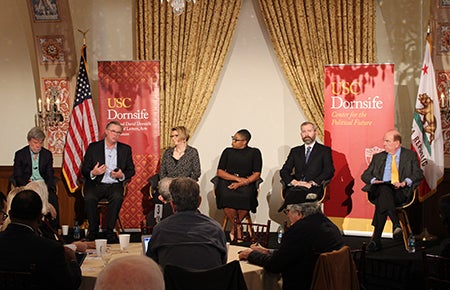
Experts: It is indeed a women’s wave, but is it a ‘blue wave’?
“Wave” is the word this month as midterm election results roll in, but experts at a post-election conference hosted by USC Dornsife’s Center for the Political Future debated on Friday whether it was truly a “blue wave” for Democrats, yet acknowledged it was undoubtedly a wave for women.
As of Friday, Democrats had gained 36 seats in the U.S. House of Representatives, including Democrat Katie Porter, who has prevailed over Republican Rep. Mimi Walters. Votes are still being counted, leaving open the possibility that Democrats could net up to 40 seats in the House. An unprecedented number of women — more than 100 — won seats in Congress this month.
Gentry Collins, the former national political director at the Republican National Committee and a fellow at the center, said that control of the House has switched parties many times over the course of history, so the term “blue wave” is misleading.
“It’s a status quo election,” argued Collins. “It fits a historical pattern of partisan change that is well within normal boundaries.”
Collins also said that, due to the Democratic wins in the House, many political analysts speculate that the fractures within the Republican Party spell trouble for the GOP in the 2020 presidential election. Collins said, though, that the Democratic Party has its own fault lines to address.
“I agree that the Republican Party is not the only party that is broken,” said Symone Sanders, a CNN commentator who was the press secretary for Vermont Sen. Bernie Sanders’ 2016 presidential campaign.

Left to right: Democratic strategists Bill Carrick and Tad Devine, Survey Director Jill Darling of the USC Dornsife Center for Economic and Social Research, political commentator Symone Sanders, former director of the Republican National Committee Gentry Collins and USC Dornsife Center for the Political Future Director Robert Shrum discuss the 2018 midterm election results at a post-election conference.
Symone Sanders, who is not related to the Senator, agreed with Collins’ criticism, noting that Democrats made some missteps when their party chose not to support some candidates while channeling its support behind others.
The candidates that it failed to back “were folks that jumped up and put their own names on the ballot — much to the chagrin of the Democratic apparatus,” she said. “We need to rethink what it means to be electable, who is electable and who can win races. Don’t assume that black or brown [Latino] candidates can’t win somewhere.”
Sanders will join the Center for the Political Future as a fellow in January.
The midterm election has provided plenty of evidence that diverse candidates can win, panelists noted. Lucy McBath, a gun control advocate whose son was killed in a 2012 shooting, defeated Republican Rep. Karen Handel for her Georgia congressional seat.
Women’s wave
Some experts have dubbed the latest women’s wave a “pink wave,” although the name is debatable, said Ange-Marie Hancock Alfaro, Dean’s Professor of Gender Studies and professor of political science, sociology and gender studies.
“The wave metaphor may not be the right metaphor,” Hancock said. “Waves come and recede. I would actually wonder if we should have used the color lavender because so much of what was pink was actually blue.”
Experts on the panel that Hancock Alfaro moderated included former Democratic Sen. Barbara Boxer, who was among a group of women voted into office in 1992, then called the “Year of the Woman.” That wave came a year after Anita Hill described to a congressional committee allegations of sexual harassment by Clarence Thomas, who was confirmed to the U.S. Supreme Court despite her testimony.
Boxer, who retired from office in 2017, said she thinks women voters for this latest election were motivated emotionally, not only by the women’s marches but by recent images, such as those of immigrant families being separated at the U.S.-Mexico border.
“These were iconic moments,” said Boxer. “I know you saw this, too: the photograph from Charlottesville of the torches” carried at the August 2017 “Unite the Right Rally” by members of white nationalist and neo-Nazi groups.
The Trump factor
Lisa Garcia Bedolla, a political expert from the University of California, Berkeley, countered that the photographs also may have motivated voters who support President Donald Trump and who want tougher immigration policies.
“There are those people who are on the other side, … who said ‘it’s their parents’ fault for bringing them,’” she said, referring to the treatment of immigrant children.
Preliminary data from the USC Dornsife/Los Angeles Times poll indicates that Trump was a motivating factor. Nearly 40 percent cited their opposition to him as a motivating factor to vote in their local U.S. House race, while just under 30 percent said their support for him was motivating for them to vote.
That said, three-quarters of the voters said their views on the candidate were more important than their views of Trump.
Garcia Bedolla showed data from the New York Times that indicated women voters were a key subgroup in the midterm election.
“Context matters,” she said. “White women left Republicans, but the House Democrats failed to win them completely. There is a gap across all groups. The reason women voted overall Democrat is because of the women of color. But white women have been at parity” for Democrats and Republicans.